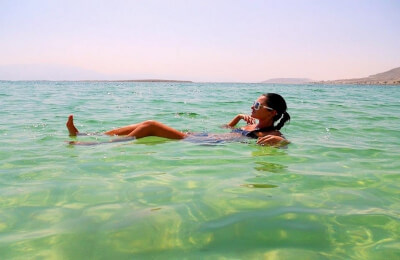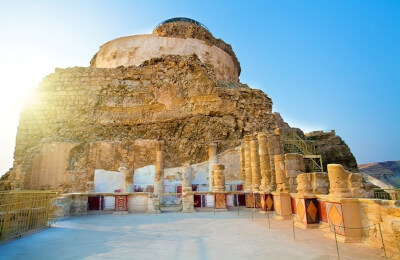We also found excursions from other cities that are close to your departure city
Other excursions that also deserve your attention
The Judean Desert: Israel's Wilderness of Wonder
Nestled between the city of Jerusalem and the Dead Sea, the Judean Desert stands as a stark contrast to the green and fertile landscapes that one might associate with parts of the Holy Land. Its rugged terrains, deep canyons, and sweeping vistas paint a picture of desolation and beauty, intertwined with a rich tapestry of history, religion, and culture.
Geographical Marvel
The Judean Desert, a relatively small desert region, stretches across 1,500 square kilometers. It is unique in its topography and climatic conditions: 1. Rain Shadow Effect: Despite its proximity to Jerusalem, the desert receives scant rainfall, less than 100mm annually. This is due to the rain shadow effect created by the Judean Mountains, which prevents moisture-laden winds from reaching the desert. 2. Wadis and Canyons: The landscape is scarred by numerous wadis (dry riverbeds) and canyons. These wadis can suddenly fill with water during rare rainstorms, causing flash floods. 3. Dead Sea: To the east, the desert slopes down to the shores of the Dead Sea, the lowest point on Earth's surface, sitting at around 430 meters below sea level.
Historical Significance
The seemingly inhospitable environment of the Judean Desert has played a surprisingly significant role in the history of its inhabitants. 1. Hermitage and Monasticism: Drawn to its solitude, early Christian monks established hermitages and monasteries. The desert's quietude offered an environment conducive to meditation and spiritual reflection. 2. Dead Sea Scrolls: In the 1940s and 1950s, ancient manuscripts known as the Dead Sea Scrolls were discovered in the Qumran Caves, offering invaluable insights into Jewish life during the Second Temple period. 3. Fortresses: The desert has been a strategic location for fortifications. The most famous of these is Masada, a fortress built by King Herod. It later became the last stronghold for Jewish rebels against the Romans, culminating in a tragic mass suicide.
Flora and Fauna
Despite its arid conditions, the Judean Desert supports a range of life. 1. Plants: Certain plants have adapted to the desert's harsh environment, including the Sodom apple, saltwort, and Dead Sea wormwood. After rare rains, the desert can burst into a brief but spectacular bloom. 2. Wildlife: The desert is home to species such as the Nubian ibex, hyrax, and various reptiles. At night, one might also spot nocturnal creatures like the caracal or desert fox.
Modern Exploration
Today, the Judean Desert is not just a place of historical and religious significance; it's a hotspot for adventure and exploration. 1. Hiking: The desert offers numerous hiking trails, ranging from easy walks to challenging treks. Popular routes include the Ein Gedi Nature Reserve and the trek up to Masada. 2. Bedouin Experience: Several Bedouin communities offer tourists an insight into their traditional way of life, including tent accommodations, traditional meals, and camel rides. 3. Spa Resorts: On the shores of the Dead Sea, numerous spa resorts have sprung up, leveraging the mineral-rich mud and saline waters for therapeutic treatments.
Conservation and Challenges
The Judean Desert, like many ecosystems worldwide, faces challenges. 1. Mining Activities: The mineral-rich environment, especially around the Dead Sea, has led to extensive mining. This poses threats to the natural landscape and the delicate balance of the ecosystem. 2. Tourism Impact: The influx of tourists, if not managed sustainably, can lead to degradation of the environment and its natural and historical sites. 3. Water Scarcity: With climate change and over-extraction of water sources, the desert's already arid conditions are exacerbated, impacting its flora and fauna.
Conclusion
The Judean Desert, with its stark beauty, serves as a silent witness to millennia of history. It's a place where nature's resilience is evident, where the ancient intertwines with the modern, and where the spiritual finds a home amidst the wilderness. The desert beckons with its tales of endurance and faith, inviting us to tread its paths and discover its many mysteries.





